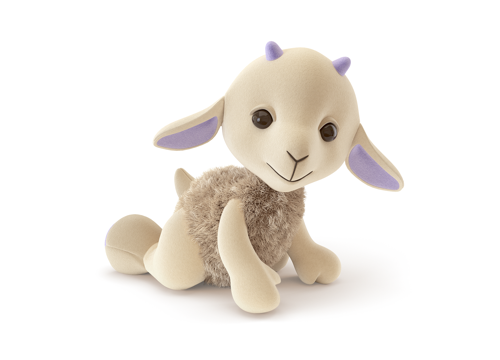Babies are actually born with all 20 of their baby teeth already in their jawline. Just below the gum margins, those little pearlers are waiting to erupt. This fact is contrary to common belief, that the teeth don’t start evolving until the few short months before they emerge.
Even when in utero, your baby’s teeth were already forming from around six weeks gestation. They’ve been sitting waiting for a long time.
Baby teeth are also known as milk teeth, primary teeth and deciduous teeth. Whatever you call them, understand that they are precious and worth looking after.
What Age Do Babies Start Teething?
Some babies are actually born with a tooth. This interesting phenomenon occurs in around 1 in every 2000 births. Most babies start to teethe at around six months of age, with some as early as four months. Every baby will have their own individual teething rates and stages – some take their time with every new little tooth to emerge and others, have multiple teeth erupting like little mushrooms all at one time. There can be long breaks between teeth erupting through the gums, followed by a period of time making up for the pauses. By approximately three years of age, all 20 teeth have generally made an appearance.
Like all other stages of development, individual traits play an important role in when to expect teeth to erupt. But as a rule, teething follows a fairly predictable pattern of eruption.
Small age variations are common, though it’s reasonable for parents to feel a little confident about which teeth to expect at what age.
Babies Are Born With These Teeth Below Their Gums
- 4 central incisors
- 4 lateral incisors
- 4 canine teeth
- 4 first molars
- 4 second molars
Every Tooth Has a Specific Purpose
- The front teeth or incisors at the front of the mouth have a sharp biting edge. Incisors are used for cutting and shearing food into more easily chewable pieces. Four central and four lateral incisors erupt for babies – generally the lower central incisors are the first to appear.
- The canines sit at the sides or corners of the mouth and have a sharp, pointed surface. This helps with gripping and tearing food. Four canine teeth erupt with primary (first) dentition. Some people know the canines as ‘fangs’.
- The molars are the largest of all teeth. They have a large flat biting surface that is designed to chew, crush and grind food so it’s soft and safe to swallow. There are eight molars in primary dentition.
Why Are My Baby’s Teeth Jagged?
Every tooth develops from separate lobes, each forming a different part of the tooth. Under the gums, these lobes eventually grow together. As the tooth erupts from the gums it can have a serrated or ‘postage stamp’ edge where the lobes have came together. These are called mamelons and are a sign that the right, left and middle lobes have joined.
Some people believe mamelons help baby teeth to cut through the gums. Eventually, the mamelons are ground down to a smooth and even surface. Eating, chewing, biting down as well as how the baby’s teeth sit alongside each other, all help to wear down the serrations.
But They’re Only Baby Teeth!
Baby teeth play an important role in being able to chew food easily. Quite apart from eating, one of their most valuable roles is to be placeholders for when the permanent teeth come through.
Without the baby teeth minding the correct position for the secondary teeth, there is a risk of misalignment or tooth crowding. The permanent teeth don’t have a template for where they should emerge and instead, overcrowding happens. This is a problem for eating and also causes excessive wear of the teeth. This means uneven wear and tear as individual teeth need to do work they’re not designed for.
Baby teeth also help children to pronounce words properly. Lisps and incorrect pronunciation are common when the tongue doesn’t sit in the right position. Sounds can’t form correctly because the tongue, teeth and gums aren’t in their correct relationship to control air movement.
Facts About Teething Ages and Stages
- A child’s jaw continues to grow so it is large enough to accommodate 32 permanent, much bigger teeth.
- The outer enamel covering of baby teeth is not as thick as in adult teeth. This thinner enamel makes the baby teeth look whiter, but it also means baby teeth are at more risk of decay.
- Baby teeth have a different root structure from adult teeth. This allows the roots to dissolve as the adult teeth grow underneath them.
- Baby teeth are very small and often look uneven. Gaps are common but not an indication that the permanent teeth will have gaps.
- Sometimes white or yellow patches have formed on baby teeth. This can be related to maternal fever or viral illness during pregnancy.
Five Important Facts About Baby Teething
- Babies have 20 primary teeth
- The first teeth to erupt are generally the lower central incisors
- Most babies have all their primary teeth by around 3 years of age
- The first secondary or permanent teeth to erupt are the molars
- Permanent teeth push the baby teeth out
Knowing what to expect and what to look for with your baby’s teething can help to boost your own confidence and enjoy this interesting stage of your baby’s development. Because teething, like most other ages and stages of your baby’s maturity, will happen no matter what you do. It makes sense to just sit back and enjoy this time.
Remember,
Make an appointment with your child health nurse for more information about your baby’s teething. Also, speak with your dentist for specific information about your baby’s teething ages and stages.




